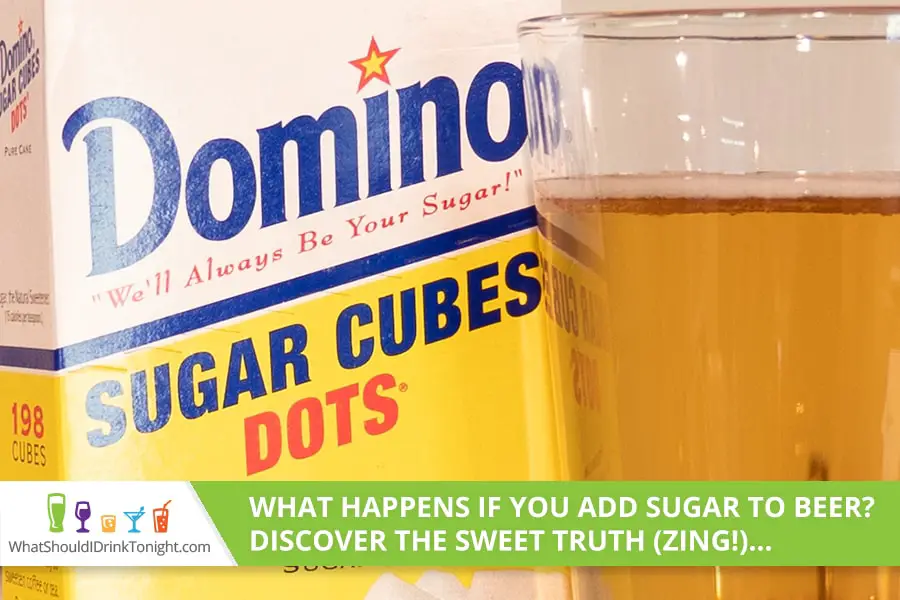Sugar is food for yeast, and alcohol is what is produced when yeast metabolizes sugars, so adding sugar to beer is a necessary step in the process. The key is to know when to add the sugar, how much to add, and what kind to add.
What happens if you add sugar to beer? There are four primary reasons that you would want to add sugar to beer. If you add it during primary fermentation, it will increase the ABV of the beer. You can also add sugar to lighten the body or to alter the flavor or color of the brew. Bottle conditioning your beer is another reason you would add sugar.
Homebrewing has become an extremely popular pastime as the increase in microbreweries and craft beers has continued over the past 10-15 years. Whether you’ve got some experience in this area or are just starting to think about giving it a try, knowing how and when to use sugar is an important part of the process.
How and When to Add Sugar to Beer
The process of setting up a beer will vary greatly depending on the methods that you are using. Regardless of how you get there, you will eventually arrive at a point where you have what brewers call the “wort.” This is the result of combining and heating the basic elements of beer: water, grain, and flavoring agents (hops).
Once you have your wort and it has cooled to the point where it will not kill the yeast, you take the step of pitching the yeast. It is the yeast feeding on sugars in your wort that produces alcohol. If you add sugar to your wort during the cook or during the “primary fermentation” phase of brewing, it will result in a higher alcohol content for your beer.
Depending on the types of sugar you add, and precisely how far along your beer is in the fermentation phase, the result might be a lightening of the body of the beer. Alcohol is lighter than water, and so beer with higher alcohol content should have a lighter body. Certain sugars can also impart color and flavor characteristics to your brew.
When your beer has finished fermenting, it will be lightly carbonated or mostly flat. One of the easiest ways for homebrewers to carbonate beer is called bottle conditioning. This method requires you to add additional sugar. Once you seal the beer in the bottle, the fermentation of that final bit of sugar inside the sealed bottle will have the effect of force carbonating your beer.
The Myth of Sugar and Cidery Beer
Some brewers and craft beer enthusiasts will swear that adding sugar to your beer will give the beer a cidery flavor. This is a myth that is easily disproved to anyone who is willing to listen to reason. The kinds of off-flavors that people describe as cider-y are almost always traceable to poorly sanitized brewing equipment or some other misstep in the brewing process.
While cidery flavors should not be blamed on sugar, there are certain sugars that have noticeable effects on the finished flavor of beer. Since there are so many different kinds of sugar and so many sources that you can incorporate in your brewing, it’s worth taking a look at what those are.
Kinds of Sugars and Where to Find Them
As we said above, beer’s primary ingredients are water, grain, and hops. Grain contains high starch contents, but heating the water and the grain together breaks those starches down into sugars. When your mash is complete, and your wort is cooling, there will be fructose, maltose, glucose, and sucrose present. Each of these sugars is fermentable by beer yeasts.
Fructose
Fructose is a rapidly fermentable sugar that is derived from a variety of starches. Fructose is also known as Levulose.
Glucose
Glucose is another very fast fermentable sugar. Some brewers use the terms “Glucose” and “Dextrose” interchangeably, though Dextrose is derived specifically from corn.
Sucrose
Rapidly fermentable by beer yeast, Sucrose is a natural fermentable found in malts.
Maltose
A slower fermentable, it occurs naturally in malt and other sweeteners.
Lactose
Lactose is non-fermentable by beer yeast, though it can be fermented by different types of wild yeast. It imparts a sweet flavor in beer and is commonly used to turn stouts into “milk stouts.”
So then, every source of sugar that you can add to your beer, from maple syrup to table sugar, is ultimately going to resolve as one or more of these types of sugars. A visit to your local homebrew supply store will give you a good idea of just how many options there are for adding sugars to your beer.
Candi Sugar
This is a very popular option for Belgian-style beers and strong ales. It is a slowly crystalized sucrose that can end up white, amber, or brown in color. The darker the color, the more caramelized the crystals and the more of an effect it will have on the color and flavor of your beer. These sugar sources are used to lighten the body of the beer and increase the alcohol content.
Corn Sugar
As we said above, corn sugar is known as Dextrose and is molecularly identical to Glucose. Corn sugar is what most brewers prefer for bottle conditioning their beer. Dextrose can also be used to lighten the body of the beer and increase ABV%.
Specialty Sources
There are many other sources that you can experiment with in your brewing recipes. Some, such as maple syrup, molasses, and agave syrup, have become pretty popular. Others like beet and cane sugar, palm sugar, and raw sugar are riskier to use in the brewing process because they offer more potential problems than they do upsides.
Sugary Beer and Bottle Conditioning
If you’ve ever been getting ready to pop the top on a bottle of homebrewed beer only to find yourself holding onto a miniature version of old faithful, then you know just how bad things can get when bottle conditioning goes wrong.
There are two main ways to perform bottle conditioning. The first is bottle priming, a method that has brewers place sugar directly into the individual bottles before filling them with beer. This method makes it difficult to control the exact weights of fermentable sugar that go into each bottle. When too much sugar goes in, the beer geyser is the result.
The other way to bottle condition beer is to batch prime your beer. This method has brewers add a set amount of fermentable sugar to the whole batch of beer before portioning it into bottles. Because the fermentables are being introduced into a larger volume, small measuring errors make less of a difference.
Giving Sugar a Try
Are you ready to try adding sugar to your next homebrew project? If you’ve read all of the information in this article, you definitely know enough to begin the process of experimenting. Ultimately it will be experimentation and experience that will help you develop an approach that suits your brewing process and your taste in beer.
Half of the fun of homebrewing is tinkering with the results until you’ve gotten everything just perfect and then challenging yourself to do it that well every time. Think of adding sugar as one more tool in your brewer’s tool kit.
It can be a great way to increase the alcohol content of the beers you brew. As you experiment, you’ll find that you can also affect changes on the body, color, and flavor of your beers that range from subtle to significant. Give it a try and see what you can come up with.

